Groundwater Chemistry and Stratification in the Flooded Hard-Coal Mine Shaft “Nowy I” (Nowa Ruda Region, SW Poland)
Abstract
:1. Introduction
2. Materials and Methods
2.1. Study Area
- The Noworudzka sequence of sediments (Namurian-Visean) that is formed by weathered formations, represented by conglomerates and diabase-gabbro breccia, argillites, slates, refractory sandy and clayey shales with coal beds. This layer is formed irregularly and its thickness does not exceed a few meters [43,45,49]. The weathered zone is enriched with carbonates, mainly calcite. It has been identified as a cement and filling of fissures in weathered rocks and conglomerates [50]. Additionally, single calcite crystals have been found in the conglomerates.
- Approximately 12 m thick Żacler Beds are the most fully developed layers within the Słupiec mining area and belong stratigraphically to Westphalian B (ca. 70 m thick, sandy fraction: sandstones, conglomerates with sandy and clayey shales with four coal seams numbered: 301, 302, 303 and 304) and Westphalian A (thickness 40–100 m, clayey fraction: sandy and sandy-loamy shales with 11 coal seams numbered: 405–415) [46]. The coal seams in the Żacler Beds are in the form of clusters, often with interbedded sandy shales layers of several tens of centimeters to several meters thickness. They are enriched in sulfide (pyrite) that amounts up to 0.8% vol. [51]. Within the Upper Carboniferous coal-bearing strata, a significant amount of gases (methane and carbon dioxide) have been identified. Its variability is related to geological structure, tectonics and the gas origin [46].
- Stephanian layers that overlay the Żacler Beds discordantly, are composed mostly of clastic sediments: sandstones and conglomerates with clay–sandy shale bands. Their thickness is 60–90 m [46].
- Permian deposits of the Rotliegend spread the western part of the area and are clearly visible in the morphology as Włodzickie Hills. They consist of sandstones and conglomerates with sandy and clayey shale bands, occasionally melaphyrs. The thickness of these series of rocks is 150–250 m, rising to 600–800 m to the west [46].
- Quaternary sediments are represented mostly by Pleistocene sandy and silty clay, loam, as well as glacial clay with rock debris. The youngest sediments are riverine (Holocene) sands and gravels, occurring along stream valleys [46].
2.2. Hydrogeological Background
2.3. Chemistry of Mine Water Inflowing to the Mine During Operation
- The water at level +170 m showed TDS in the range of 1050–1442 mg/L and was four-ion of SO–HCO–Mg–Ca–type (Figure 6).
- At the +50 m level the inflowing water showed TDS in the range of 1135–1356 mg/L and was three- and four-ion of SO–HCO–Na or SO–HCO–Na–Mg or HCO–SO–Na–Mg–type. Higher concentrations of Na and lower concentrations of Ca and Mg were observed among cations.
- The water inflowing to workings located at the level −110 m was characterized by low TDS in the range of 324–532 mg/L. It was four-ion water of HCO–SO–Mg–Ca or HCO–SO–Na–Mg–type.
- The water at the −270 m level showed TDS in the range of 844–1450 mg/L and was four-ion of SO–HCO–Cl–Na or SO–HCO–Cl–Na–type.
2.4. Sampling and Analitycal Methods
3. Results
4. Discussion
5. Conclusions
Author Contributions
Funding
Acknowledgments
Conflicts of Interest
Abbreviations
| KWK | hard-coal mine |
| USCB | Upper Silesian Coal Basin |
| LSCB | Lower Silesian Coal Basin |
| a.s.l. | above sea level |
| b.g.l. | below ground level |
| EC | electric conductivity |
References
- Hill, A. Coal: A Chronology for Britain; Monograph of Northern Mine Research Society, 2012; Volume 94, Available online: https://www.nmrs.org.uk/ (accessed on 19 November 2020).
- Gołębiowski, A.; Kozłowski, B. Closing Mines in Wałbrzych; Okręgowy Urząd Górniczy: Wałbrzych, Poland, 1992. [Google Scholar]
- Banks, D.; Younger, P.L.; Arnesen, R.T.; Iversen, E.R.; Banks, S.B. Mine-water chemistry: The good, the bad and the ugly. Environ. Geol. 1997, 32, 157–174. [Google Scholar] [CrossRef]
- Rogoż, M.; Posyłek, E. Hydrogeological problems connected with closure of mines in the Upper Silesian Coal Basin. In Proceedings of the 7th IMWA Congress, Ustroń, Poland, 11–15 September 2000; pp. 319–330. [Google Scholar]
- Mądrala, M.; Worsa-Kozak, M. Groundwater system of Grodziec Syncline in Iwiny region (SW Poland) 10 years after abandonment of dewatering in “Konrad” mine. In Proceedings of the 11th International Mine Water Association Congress—Mine Water—Managing the Challenges (IMWA), Aachen, Germany, 4–11 September 2011; pp. 393–397. [Google Scholar]
- Younger, P. Coalfield closure and the water environment in Europe. Min. Technol. 2002, 111, 201–209. [Google Scholar]
- Sechman, H.; Kotarba, M.; Dzieniewicz, M.; Romanowski, T.; Fiszer, J. Evidence of methane and carbon dioxide migration to the near surface zone in the area of the abandoned coal mines in Wałbrzych District (lower Silesian Coal Basin, SW Poland) based on periodical changes of molecular and isotopic compositions. Int. J. Coal Geol. 2017, 183, 138–160. [Google Scholar]
- Zeman, J.; Cernik, M.; Supikova, I. Mining and Its Environmental Impact II—Stratification of Mine Water After Flooding, Its Causes and Consequences; Ekomonitor: Chrudim, Czech Republic, 2008. [Google Scholar]
- Zeman, J.; Šupíková, I.; Černík, M. Mine Water Stratification at Abandoned Mines and its Geochemical Model. In Proceedings of the 10th International Mine Water Association Congress, Karlsbad, Czech Republic, 2–5 June 2008; pp. 183–186. [Google Scholar]
- Ladwig, K.; Erickson, P.; Kleinmann, R.; Posluszny, E. Stratification in Water Quality in Inundated Anthracite Mines, Eastern Pennsylvania; US Department of the Interior, Bureau of Mines: Avondale, MD, USA, 1984; Volume II, p. 35. [Google Scholar]
- Stuart, W.; Simpson, T. Variations of pH with depth in anthracite mine-water pools in Pennsylvania. U.S. Geol. Surv. Prof. Pap. 1961, 37, 82–84. [Google Scholar]
- Geller, W.; Klapper, H.; Schultze, M. Natural and Anthropogenic Sulfuric Acidification of Lakes. In Acidic Mining Lakes; Springer: Berlin/Heidelberg, Germany, 1998; pp. 3–14. [Google Scholar]
- Marsden, M.; Holloway, D.; Wilbraham, D. The Position in Scotland. In Proceedings of the UK Environment Agency Conference on “Abandoned Mines: Problems and Solutions”; Bird, L., Ed.; University of Sheffield: Sheffield, UK, 1997; pp. 76–84. [Google Scholar]
- Younger, P.L. Coalfield Abandonment: Geochemical Processes and Hydrochemical Products. In Energy and the Environment: Geochemistry of Fossil, Nuclear and Renewable Resources; Society for Environmental Geochemistry and Health, MacGregor Science: Insch, UK, 1998; Volume 1, p. 29. [Google Scholar]
- Younger, P.L. Holistic remedial strategies for short- and long-term water pollution from abandoned mines. Min. Technol. 2000, 109, 210–218. [Google Scholar] [CrossRef]
- Younger, P.L. Predicting temporal changes in total iron concentrations in groundwaters flowing from abandoned deep mines: A first approximation. J. Contam. Hydrol. 2000, 44, 47–69. [Google Scholar]
- Younger, P.L. Mine water pollution in Scotland: Nature, extent and preventative strategies. Sci. Total Environ. 2001, 265, 309–326. [Google Scholar] [CrossRef]
- Younger, P.L. Mine water pollution from Kernow to Kwazulu-Natal: Geochemical remedial options and their selection in practice. Geosci. South-West Engl. 2002, 10, 255–266. [Google Scholar]
- Nuttall, C.A.; Younger, P.L. Hydrochemical stratification in flooded underground mines: An overlooked pitfall. J. Contam. Hydrol. 2004, 69, 101–114. [Google Scholar] [CrossRef]
- Wolkersdorfer, C. Water Management at Abandoned Flooded Underground Mines; Springer: Berlin/Heidelberg, Germany, 2008; pp. 1–465. [Google Scholar] [CrossRef]
- Geller, W.; Schultze, M.; Kleinmann, R.; Wolkersdorfer, C. Acidic Pit Lakes—The Legacy of Coal and Metal Surface Mines; Springer: Berlin/Heidelberg, Germany, 2013. [Google Scholar]
- Huisamen, A.; Wolkersdorfer, C. Modelling the hydrogeochemical evolution of mine water in a decommissioned opencast coal mine. Int. J. Coal Geol. 2016, 164, 3–12. [Google Scholar] [CrossRef] [Green Version]
- Wolkersdorfer, C.; Nordstrom, D.K.; Beckie, R.D.; Cicerone, D.S.; Elliot, T.; Edraki, M.; Valente, T.; França, S.C.A.; Kumar, P.; Lucero, R.A.O.; et al. Guidance for the Integrated Use of Hydrological, Geochemical, and Isotopic Tools in Mining Operations. Mine Water Environ. 2020, 39, 204–228. [Google Scholar]
- Mugova, E.; Wolkersdorfer, C. A Review of Mine Water Stratification. In Altbergbau-Kolloquium—Tagungsband; Meier, G., Ed.; Nossen (Wagner): Wieliczka/Cracov, Poland, 2018; Volume 18, pp. 12–132. [Google Scholar]
- Mugova, E.; Wolkersdorfer, C. Stratification in Flooded Underground Mines—State of Knowledge and Further Research Ideas. In Mine Water—Technological and Ecological Challenges; Khayrulina, E., Wolkersdorfer, C., Polyakova, S., Bogush, A., Eds.; Perm State University: Perm, Russia, 2019; pp. 40–45. [Google Scholar]
- Rapantova, N.; Licbinska, M.; Babka, O.; Grmela, A.; Pospisil, P. Impact of uranium mines closure and abandonment on groundwater quality. Environ. Sci. Pollut. Res. 2013, 20, 7590–7602. [Google Scholar]
- Engineers, S. Mahanoy Creek Mine Drainage Pollution Abatment Project, Project SL 197. In Operation Scarlift Commonwealth of Pennsylvania; Shapp, M.J., Ed.; GDoER Pottstown: Pennsylvania, PA, USA, 1975. [Google Scholar]
- Melchers, C.; Coldewey, W.; Goerke-Mallet, P.; Wesche, D.; Henkel, L. Sanierte Bergbaustandorte im Spannungsfeld zwischen Nachsorge und Nachnutzung: Proceedings des Internationalen Bergbausymposiums WISSYM_2015; Bad Schlema, 31. August bis 3. September 2015; Wismut GmbH: Chemnitz, Germany, 2015; pp. 99–186. [Google Scholar]
- Álvarez, R.; Ordóñez, A.; De Miguel, E.; Loredo, C. Prediction of the flooding of a mining reservoir in NW Spain. J. Environ. Manag. 2016, 184, 219–228. [Google Scholar] [CrossRef]
- Banks, D.; Frolik, A.; Gzyl, G.; Rogoż, M. Modeling and monitoring of mine water rebound in an abandoned coal mine complex: Siersza Mine, Upper Silesian Coal Basin, Poland. Hydrogeol. J. 2010, 18, 519–534. [Google Scholar] [CrossRef]
- Duane, M.J.; Pigozzi, G.; Harris, C. Geochemistry of some deep gold mine waters from the western portion of the Witwatersrand Basin, South Africa. J. Afr. Earth Sci. 1997, 24, 105–123. [Google Scholar] [CrossRef]
- Elliot, T.; Younger, P.L. Hydrochemical and isotopic tracing of mixing dynamics and water quality evolution under pumping conditions in the mine shaft of the abandoned Frances Colliery, Scotland. Appl. Geochem. 2007, 22, 2834–2860. [Google Scholar] [CrossRef]
- Kories, H.; Rtiterkamp, P.; Sippel, M. Field and numerical studies of water stratification in flooded shafts. In Proceedings of the International Mine Water Association Symposium, Newcastle upon Tyne, UK, 20–25 September 2004; Jarvis, A., Dudgeon, B., Younger, P., Eds.; University of Newcastle: Newcastle upon Tyne, UK, 2004; pp. 1–17. [Google Scholar]
- Younger, P.L. Abandoned Coal Mines: From Environmental Liabilities to Low-Carbon Energy Assets. Int. J. Coal Geol. 2016, 164, 1–2. [Google Scholar] [CrossRef] [Green Version]
- Bao, T.; Liu, Z.L. Geothermal energy from flooded mines: Modeling of transient energy recovery with thermohaline stratification. Energy Convers. Manag. 2019, 199, 111956. [Google Scholar] [CrossRef]
- Bao, T.; Liu, Z.L. Thermohaline stratification modeling in mine water via double-diffusive convection for geothermal energy recovery from flooded mines. Appl. Energy 2019, 237, 566–580. [Google Scholar]
- Bao, T.; Meldrum, J.; Green, C.; Vitton, S.; Liu, Z.; Bird, K. Geothermal energy recovery from deep flooded copper mines for heating. Energy Convers. Manag. 2019, 183, 604–616. [Google Scholar] [CrossRef]
- Frolik, A. Stratyfikacja hydrogeochemiczna wód w zatopionych podziemnych wyrobiskach górniczych kopalń wȩgla kamiennego. Przegla̧d Górniczy 2009, 65, 84–90. [Google Scholar]
- Chudy, K. Zmiany Warunków Hydrogeologicznych w Rejonie Niecki Nowej Rudy w Zwia̧zku z Likwidacja̧ Kopalń Wȩgla Kamiennego; Wydawnictwo Uniwesytetu Wrocławskiego: Wroclaw, Poland, 2008; p. 134. [Google Scholar]
- Kazimierz, D. Sedymentacja i peleogeografia utworów górnokarbońskich w niecce śródsudeckiej. Geol. Sudet. 1971, 5, 7–75. [Google Scholar]
- Jeleńska, M.; Kαdzialko-Hofmokl, M.; Edel, J.B.; Jamrozik, L.; Petersen, N.; Soffel, H. Palaeomagnetic investigations of the Palaeozoic circum-Sowie Góry Mountains ophiolitic belt in the Sudetes, Poland. Geophys. J. Int. 1995, 122, 658–674. [Google Scholar] [CrossRef] [Green Version]
- Kadziałko-Hofmokl, M.; Mazur, S.; Werner, T.; Kruczyk, J. Relationships between magnetic and structural fabrics revealed by Variscan basement rocks subjected to heterogeneous deformation—A case study from the Kłodzko Metamorphic Complex, Central Sudetes, Poland. Geol. Soc. Spec. Publ. 2004, 238, 475–491. [Google Scholar] [CrossRef]
- Pin, C.; Majerowicz, A.; Wojciechowska, I. Upper Paleozoic oceanic crust in the Polish Sudetes: NdSr isotope and trace element evidence. LITHOS 1988, 21, 195–209. [Google Scholar] [CrossRef]
- Augustyniak, K. Atlas Geologiczny Dolnośla̧skiego Zagłȩbia Wȩglowego cz. II; Instytut Geologiczny: Warszawa, Poland, 1970. [Google Scholar]
- Bossowski, A.; Ihnatowicz, A. Atlas Geologiczny Dolnośla̧skiego Zgłȩbia Wȩglowego; Instytut Geologiczny Warszawa: Warszawa, Poland, 2006. [Google Scholar]
- Gogolewska, A.; Winiarska, A. Variability of carbon dioxide content distribution within the upper carboniferous coal-bearing strata in the nowa ruda coal basin (Lower Silesia, Poland). In Prace Naukowe Instytutu Gornictwa Politechniki Wroclawskiej; Oficyna Wydawnicza Politechniki Wrocławskiej: Wrocław, Poland, 2004. [Google Scholar]
- Kapuscinski, T.; Pozzi, M. Contribution to the Knowledge of Differentiation of the Gabbro-Diabase Massif in the Slupiec Area; Kwartalnik Geologiczny: Warszawa, Poland, 1981. [Google Scholar]
- Kapuscinski, T. Petrographic study of diabase and gabbro alterations in the basement of Carboniferous sediments in the “Nowa Ruda” mine, Lower Silesia. Miner. Pol. 1991, 22, 39–48. [Google Scholar]
- Nowak, G.J. Thermal maturity of coals from the Lower Silesian Coal Basin on the background of their petrography and genesis. Biul. Panstw. Inst. Geol. 2000, 391, 89–146. [Google Scholar]
- Kapuś>ciński, T. Osady Chemicznego Wietrzenia Skał Magmowych i Kaolinitowe łupki Wȩglowe (Tonsztajny) w Polu Górniczycm Kopalni Słupic. Studium Mineralogiczno-Chemiczne; Zeszyty Naukowe Nr 367; Politechnika Śla̧ska: Gliwice, Poland, 1973; p. 82. [Google Scholar]
- Nowak, G.J.; Górecka-Nowak, A. Peat-forming environments of Westphalian A coal seams from the Lower Silesian Coal Basin of SW Poland based on petrographic and palynologic data. Int. J. Coal Geol. 1999, 40, 327–351. [Google Scholar] [CrossRef]
- Malinowski, J. Budowa Geologiczna Polski T. VII—Hydrogeologia; Wydawnictwa Geologiczne: Warszawa, Poland, 1991. [Google Scholar]
- Chudy, K.; Ma̧drala, M. Formowanie chemizmu wód podziemnych na obszarze objȩtym drenażem OG Nowa Ruda (KWK “Nowa Ruda”). Biul. Panstw. Inst. Geol. 2010, 440, 55–64. [Google Scholar]
- Motyka, J.; Czop, M.; Jończyk, W.; Stachowicz, Z.; Jończyk, I.; Martyniak, R. Wpływ głębokiej eksploatacji węgla brunatnego na zmiany środowiska wodnego w rejonie Kopalni“ Bełchatów”. Górnictwo I Geoinżynieria 2007, 31, 477–487. [Google Scholar]
- Gogolewska, A. Analysis of gas and rock outburst hazard in coal deposit within Wałbrzych coal basin using GIS tools. Min. Sci. 2011, 133, 49–73. [Google Scholar]
- Elango, L.; Kannan, R. Chapter 11 Rock—Water Interaction and Its Control on Chemical Composition of Groundwater; Elsevier Science: Amsterdam, The Netherlands, 2007; pp. 229–243. [Google Scholar] [CrossRef]
- Senior, L.A.; Sloto, R.A. Arsenic, Boron, and Fluoride Concentrations in Ground Water in and Near Diabase Intrusions, Newark Basin, Southeastern Pennsylvania; Technical Report; U.S. Geological Survey: Reston, VA, USA, 2006. [Google Scholar]
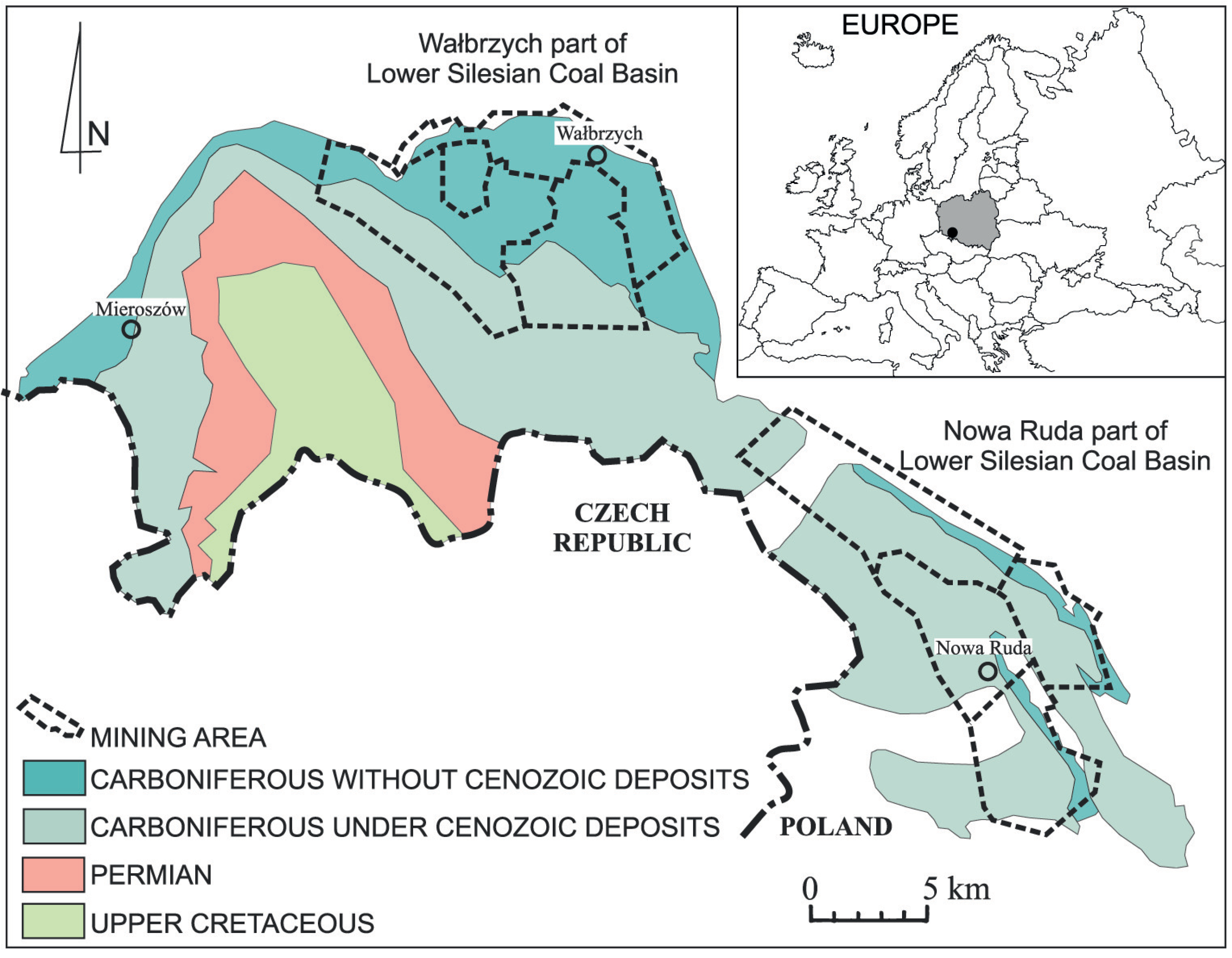
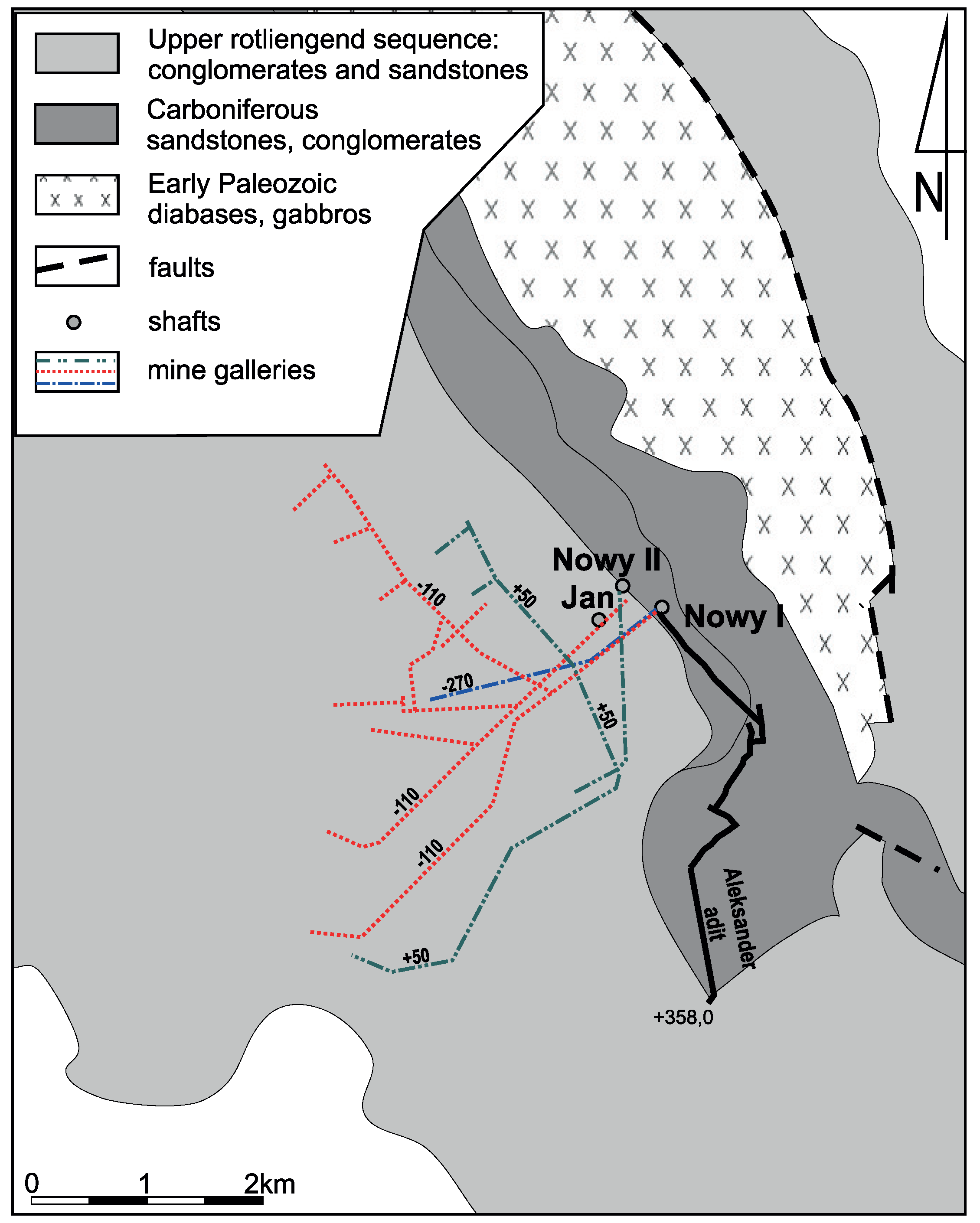
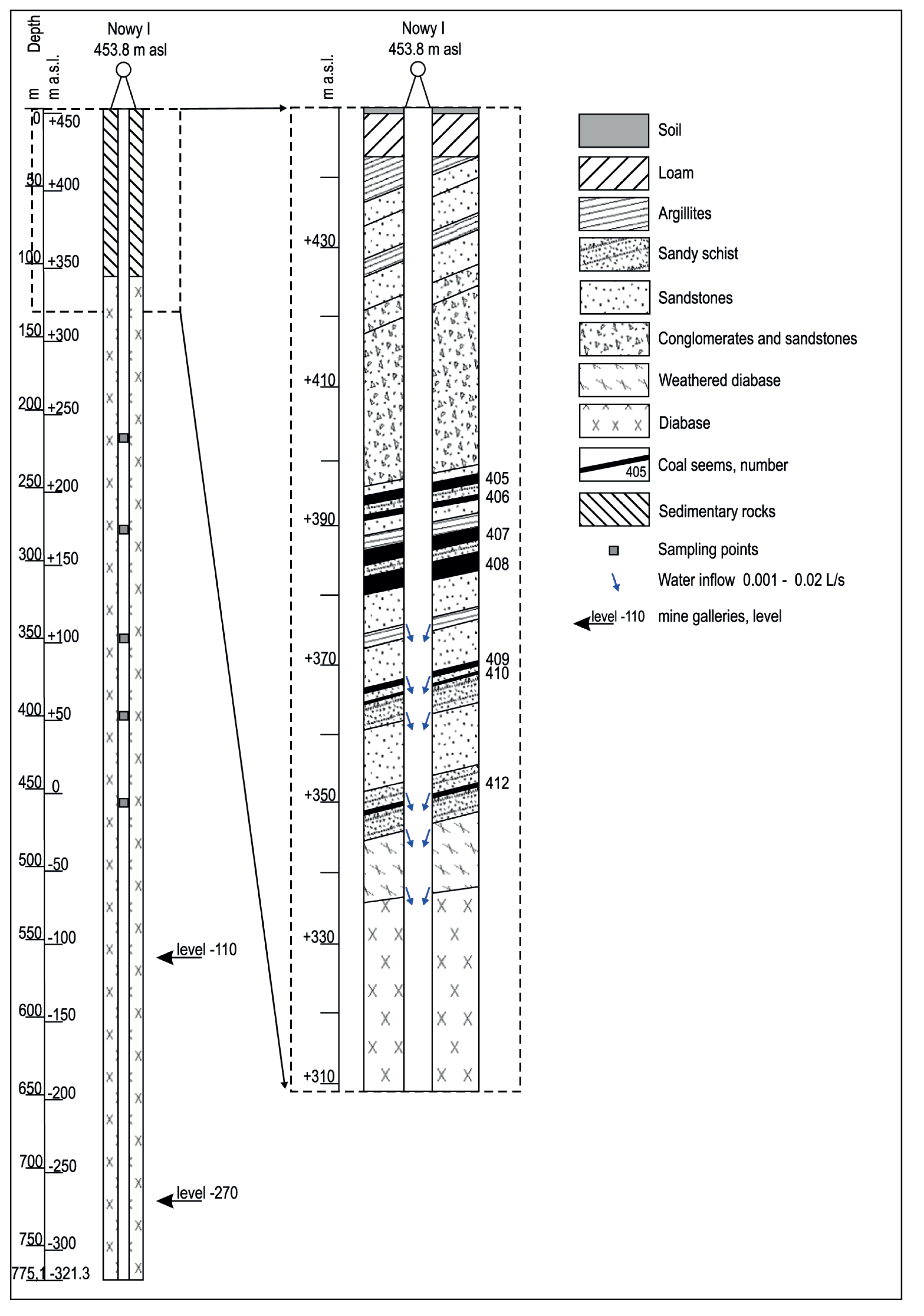
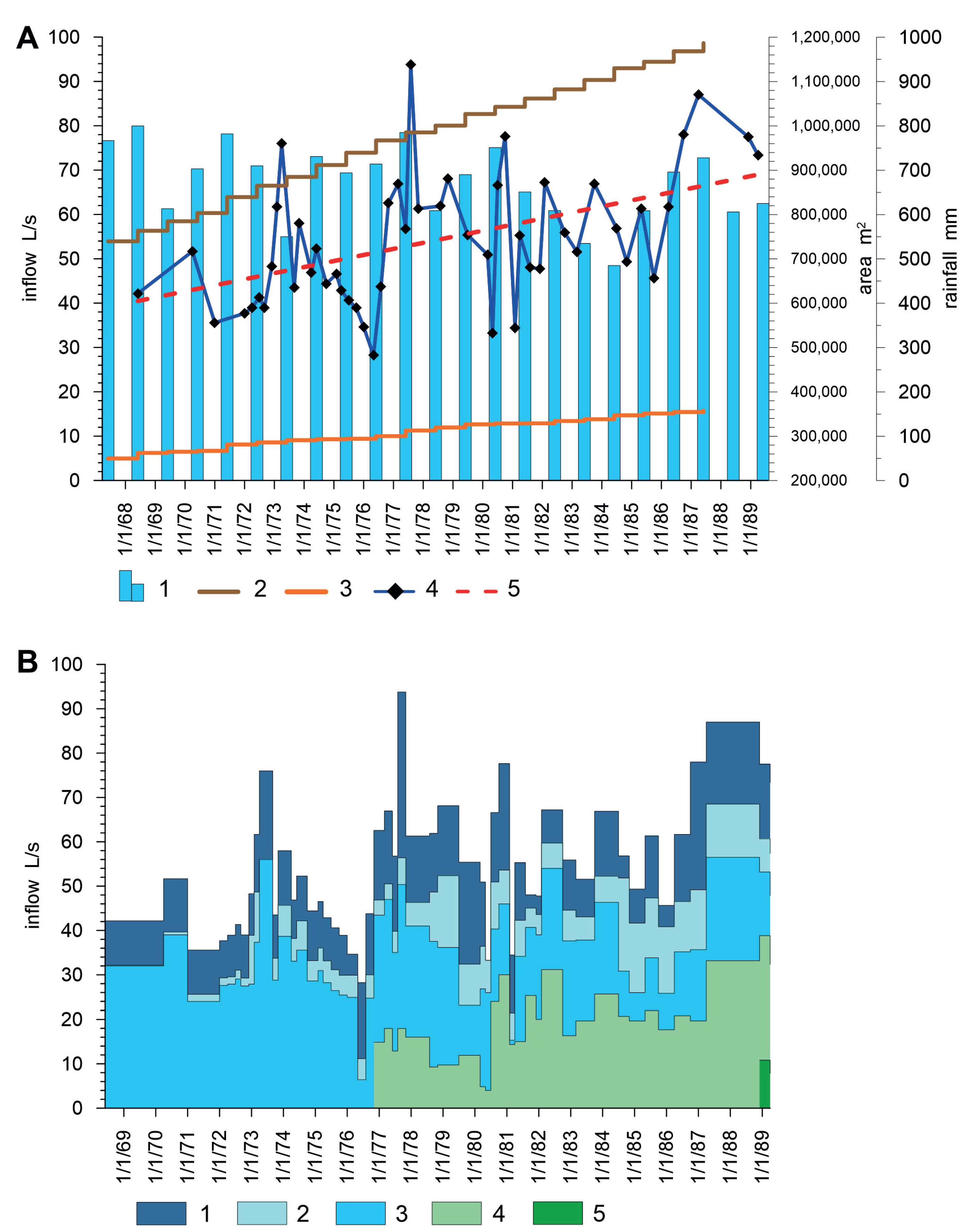


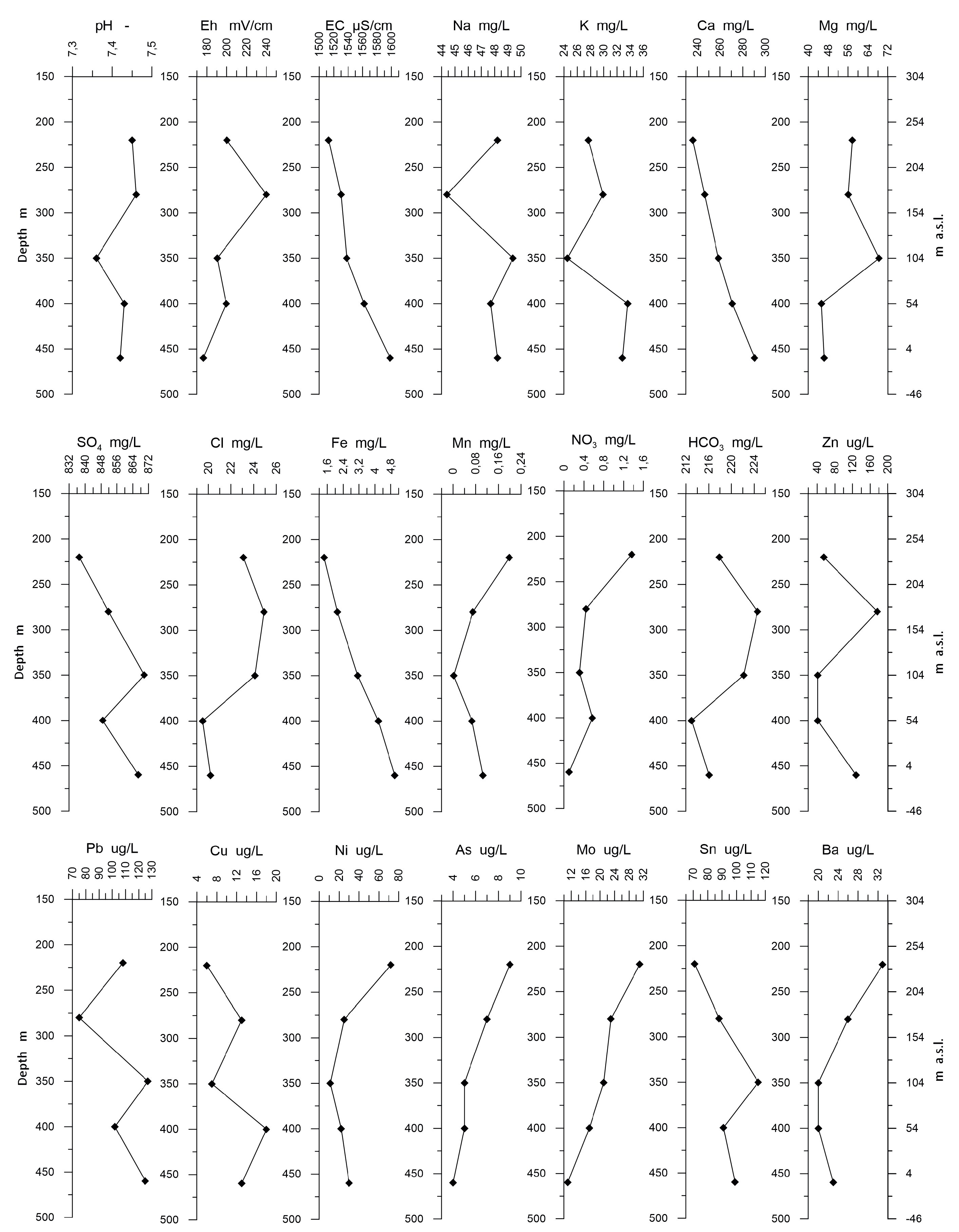
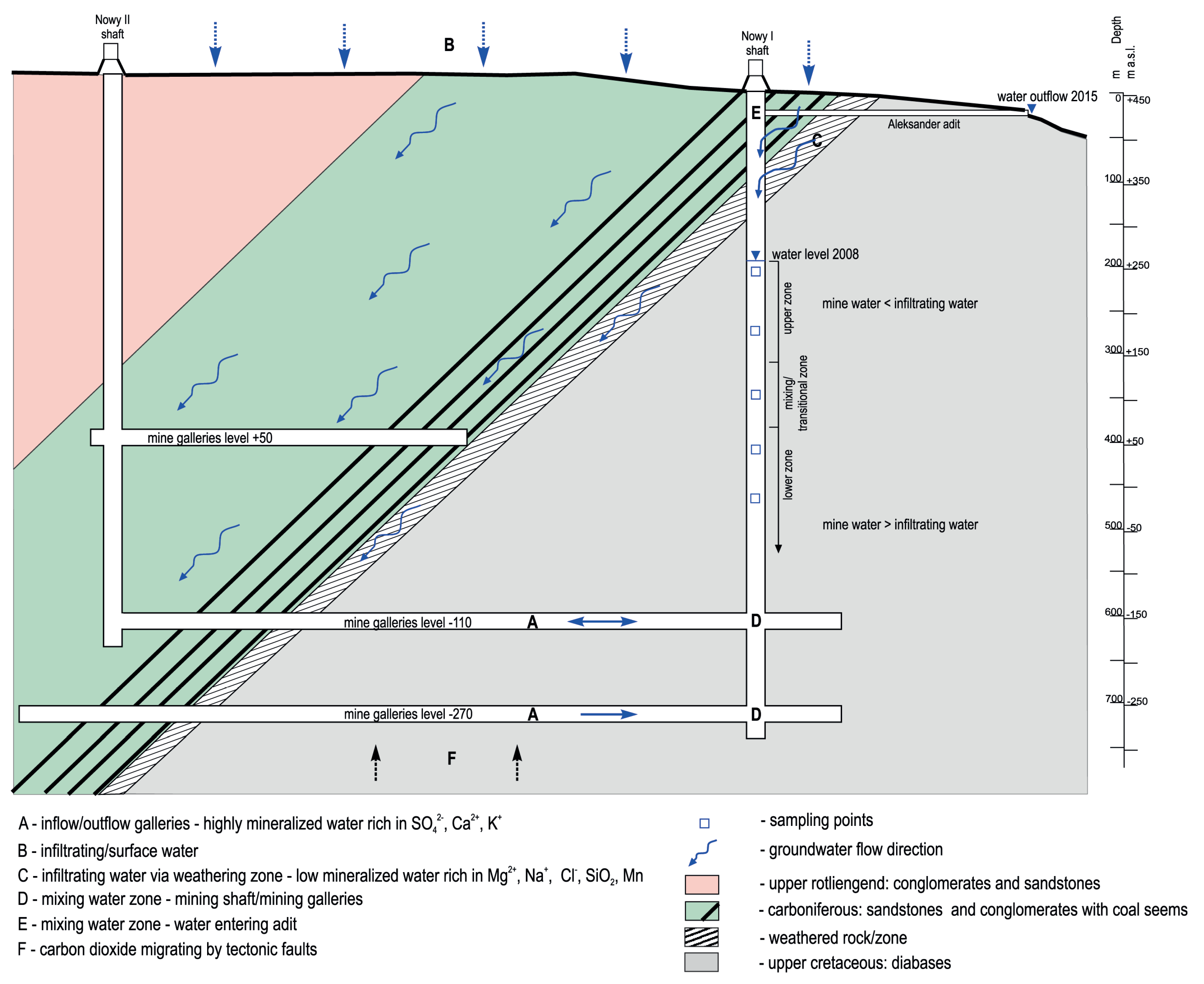
| Sample Depth | pH | Eh | EC | HCO | Na | K | Mg | Ca | SO | Cl | NO | NH | Fe | Mn | Al | SiO | |
|---|---|---|---|---|---|---|---|---|---|---|---|---|---|---|---|---|---|
| m b.g.l. | m a.s.l. | mV/cm | S/cm | mg/L | mg/L | mg/L | mg/L | mg/L | mg/L | mg/L | mg/L | mg/L | mg/L | mg/L | mg/L | mg/L | |
| 220 | 233.8 | 7.45 | 200 | 1513 | 217.8 | 48.21 | 27.67 | 57.76 | 236.0 | 837.0 | 23.1 | 1.36 | 0.18 | 1.44 | 0.198 | 5.62 | 22.32 |
| 280 | 173.8 | 7.46 | 240 | 1530 | 224.5 | 44.39 | 29.90 | 56.04 | 246.4 | 851.8 | 24.9 | 0.44 | 0.09 | 2.11 | 0.070 | 8.45 | 18.36 |
| 350 | 103.8 | 7.36 | 190 | 1538 | 222.1 | 49.38 | 24.50 | 68.44 | 258.6 | 869.8 | 24.1 | 0.31 | 0.18 | 3.14 | 0.002 | 7.18 | 20.58 |
| 400 | 53.8 | 7.43 | 199 | 1562 | 212.9 | 47.70 | 33.59 | 45.20 | 270.9 | 848.9 | 19.5 | 0.57 | 0.06 | 4.17 | 0.067 | 6.19 | 19.47 |
| 460 | −6.2 | 7.42 | 176 | 1598 | 216.0 | 48.21 | 32.82 | 46.34 | 290.5 | 866.7 | 20.2 | 0.10 | 0.10 | 5.01 | 0.106 | 5.24 | 18.83 |
| “Aleksander” adit | 6.42 | 213 | 2230 | 479.0 | 92.03 | 18.19 | 138.56 | 230.3 | 972.1 | 25.1 | 0.33 | 0.01 | 0.26 | 3.345 | 0.12 | 13.84 | |
| Sample Depth | Pb | Cd | Cu | Ni | Zn | Cr | As | Mo | Sn | Ba | Co | |
|---|---|---|---|---|---|---|---|---|---|---|---|---|
| m b.g.l. | m a.s.l. | g/L | g/L | g/L | g/L | g/L | g/L | g/L | g/L | g/L | g/L | g/L |
| 220 | 233.8 | 108 | 3 | 6 | 72 | 55 | 39 | 9 | 31 | 71 | 33 | 1 |
| 280 | 173.8 | 75 | 1 | 13 | 25 | 176 | 46 | 7 | 23 | 88 | 26 | 1 |
| 350 | 103.8 | 127 | 1 | 7 | 11 | 41 | 45 | 5 | 21 | 115 | 20 | 2 |
| 400 | 53.8 | 102 | 2 | 18 | 22 | 41 | 37 | 5 | 17 | 91 | 20 | 5 |
| 460 | −6.2 | 125 | 6 | 13 | 30 | 128 | 39 | 4 | 11 | 99 | 23 | 1 |
| “Aleksander” adit | 33 | 4 | 4 | 278 | 39 | - | - | - | - | 198 | 39 | |
Sample Availability: Samples of the compounds are not available. | |
Publisher’s Note: MDPI stays neutral with regard to jurisdictional claims in published maps and institutional affiliations. |
© 2020 by the authors. Licensee MDPI, Basel, Switzerland. This article is an open access article distributed under the terms and conditions of the Creative Commons Attribution (CC BY) license (http://creativecommons.org/licenses/by/4.0/).
Share and Cite
Chudy, K.; Worsa-Kozak, M.; Wójcik, A. Groundwater Chemistry and Stratification in the Flooded Hard-Coal Mine Shaft “Nowy I” (Nowa Ruda Region, SW Poland). Water 2020, 12, 3257. https://doi.org/10.3390/w12113257
Chudy K, Worsa-Kozak M, Wójcik A. Groundwater Chemistry and Stratification in the Flooded Hard-Coal Mine Shaft “Nowy I” (Nowa Ruda Region, SW Poland). Water. 2020; 12(11):3257. https://doi.org/10.3390/w12113257
Chicago/Turabian StyleChudy, Krzysztof, Magdalena Worsa-Kozak, and Agnieszka Wójcik. 2020. "Groundwater Chemistry and Stratification in the Flooded Hard-Coal Mine Shaft “Nowy I” (Nowa Ruda Region, SW Poland)" Water 12, no. 11: 3257. https://doi.org/10.3390/w12113257
APA StyleChudy, K., Worsa-Kozak, M., & Wójcik, A. (2020). Groundwater Chemistry and Stratification in the Flooded Hard-Coal Mine Shaft “Nowy I” (Nowa Ruda Region, SW Poland). Water, 12(11), 3257. https://doi.org/10.3390/w12113257






